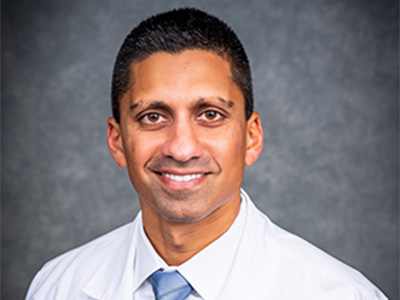 On Monday evening, Buffalo Bills safety Damar Hamlin suffered a major cardiac event after making a tackle during their game against the Cincinnati Bengals.
On Monday evening, Buffalo Bills safety Damar Hamlin suffered a major cardiac event after making a tackle during their game against the Cincinnati Bengals.
“Damar Hamlin suffered a cardiac arrest following a hit in our game versus the Bengals. His heartbeat was restored on the field and he was transferred to the UC Medical Center for further testing and treatment,” the Bills said in a statement released early Tuesday. “He is currently sedated and listed in critical condition.”
Tuesday morning, Department of Family and Community Medicine Chair Irfan Asif, M.D., who specializes in sports cardiology, spoke to the media about cardiac concerns in athletes and sporting events. Asif, who is also the associate dean for primary care and rural health, is among a team of UAB Sports and Exercise Medicine physicians who prepare for and treat cardiac concerns in athletes, from the pro level to youth sports.
Sudden cardiac arrest is the leading cause of death on the playing field, with 3 sports accounting for 75% of deaths--football, basketball and soccer. Three in 1,000 athletes may have an underlying cardiac condition that puts them at risk, while 1 in 50,000 athletes suffer a sudden cardiac arrest from an undetected cardiac condition.
While Asif did not provide care for Hamlin directly, he said the Bills player could have suffered from an injury called Commotio Cordis, an often-fatal injury that occurs when you are hit in the chest and the impact triggers a dramatic change in the rhythm of your heart. This condition is often not associated with an underlying condition and results from a direct blow to the heart at a specific time interval in the cardiac electrical rhythm.
Asif offered tips to help the community prepare for a cardiac event, no matter where it occurs. Most crucial, he said, is the availability of an automated external defibrillator, or AED, which analyzes the heart rhythm and can deliver an electric shock to restore normal rhythm. Hamlin was treated with an AED on the field, as well as with CPR.
“Every minute after suffering a cardiac arrest, you lose 7-10% of survival. Receiving CPR or AED assistance is essential and needs to happen immediately, within 3-5 minutes,” Asif said “The NFL and team’s medical staff did a great job assessing the situation with immediate response and proper care.”
Athletic teams or community leagues at any level should have an Emergency Action Plan (EAP) in place for such events, as well as an AED on hand that is readily available. The EAP should be practiced annually and the battery to the AED should be checked regularly, Asif said. For a cardiac arrest, the first step is to call 911 and locate the AED immediately. It is also important to be able to accurately recognize symptoms. Cardiac arrest victims typically have their eyes rolled back in their head, may have shallow breathing, and can present with seizure-like activity due to lack of blood flow to the brain. For any athlete with a witnessed collapse with no contact, Asif would suggest proceeding as if cardiac arrest is the cause to minimize delay in treatment.
“All coaches, trainers and parents need to have some form of training in CPR compressions and/or AED usage,” Asif said.
UAB Sports and Exercise Medicine partners with the Coach Safely foundation to train coaches in the diagnosis and treatment of sports-related injuries, including cardiac concerns. UAB Sports and Exercise Medicine also runs a Sports Cardiology Clinic for Young Athletes at UAB Hospital-Highlands. UAB Sports and Exercise Medicine providers and trainers work directly with all of the teams and athletes they cover to address cardiac concerns, along with numerous other concerns.